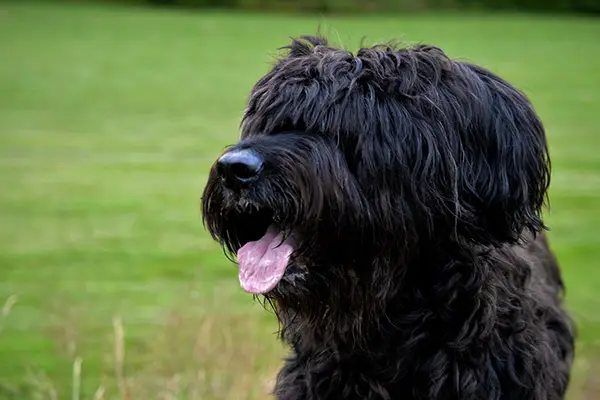Briards (also called Berger de Brie) are large to giant-sized dogs known for their gray, brown, or black, wavy coats. Their heads are topped with what people call a peek-a-boo hairdo that is naturally parted in the middle. They also feature a luxurious beard and eyebrows that always give them a questioning expression.
Most people say that Briards are “hearts wrapped in fur” because of their lovable personalities. They make great family dogs, and they are very devoted dogs. They will follow you around in whatever you do, but they are also not overly dependent.

Breed Statistics
| Dog Breed Group | Herding Group |
| Breed Size | Large to Giant |
| Height | 23-27 inches (male); 22-25.5 inches (female) |
| Weight | 55-100 pounds |
| Lifespan | 12 years |
Breed Ratings For Briards
| Energy level | |
| Exercise needs | |
| Requires attention | |
| Playfulness | |
| Trainability | |
| Shedding | |
| Grooming | |
| Friendly with family | |
| Friendly with kids | |
| Friendly with strangers | |
| Friendly with other dogs | |
| Prey Drive |
Berger de Brie History
Briards are ancient dogs that originated from Northern France in the 8th century. They were known as Chien Berger De Brie, which was derived from its place of origin, the region of Brie. These dogs were believed to have been bred as two-in-one dogs. They have two main duties – guarding and herding livestock, mainly sheep.
By the 1800s, Briards were known to be cherished by the French institution. So, in 1865, it’s not surprising that they were included in the French’s first dog show.
Napoleon is known to be one of the fans of the breed. Briards even played a significant role during the First World War as sentry dogs and rescue dogs. It’s no wonder that the breed was named to be the official breed of the French army.
It is believed that the breed came to the United States through Thomas Jefferson. According to the story, he was able to acquire a pregnant Briard named Bergere in 1789. Bergere and her litter are excellent all-around working dogs.
These dogs were then further bred and became the foundation of Briards in the US. By 1928, the American Kennel Club recognized the dog breed and now ranks 132nd as the most popular breed in the US.
Briards Temperament
Briards are described to be confident, smart, and faithful dogs. Their temperament can range from being serious to clownish dogs, which will truly make your day.
These dogs are known to be athletic and agile, very true to their origins as all-around working dogs. They need to be exercised daily, both physically and mentally, so they remain healthy and happy.
Briards are affectionate and devoted to their families. They love participating in family activities, and despite their large size, they are practically indoor pets. Briards would prefer being curled up in his own bed beside you, so make sure to take them out to exercise.
As part of the reason they were originally developed, Briards are protective. They are aloof and discriminating with strangers, so expect them to remain watchful when someone new visits your home.
Briards can also be territorial when it comes to strange animals. But they get along well with pets that grew up with them. They are also great dogs for families with kids as they are known to be gentle with children.
It’s essential to socialize these dogs early, so they maintain a stable temperament. This will help control any sign of aggression and make them more well-rounded.
Briards are independent, so training may not come as easy. They require someone confident and consistent with providing firm leadership. However, you should also be careful about crossing the line and becoming harsh.
These dogs are very sensitive and should be handled lightly. They don’t easily forgive, so remember to bring a lot of patience so you won’t hurt them.

Berger de Brie Care Requirements
- Nutrition: Briards can generally live in any type of diet. The important thing is to ensure that they receive high-quality and well-balanced meals daily. It should consist of proteins, fats, carbohydrates, vitamins, and minerals. If you’re planning to prepare home-cooked meals, you should only buy high-quality ingredients. Animal meat for proteins, fish and chicken oils for fats, whole grains for carbohydrates, and fruits and vegetables for vitamins and fiber. Take note if your dog is allergic to anything and make sure to stay away from those ingredients. When buying dog food, you should also buy the premium-quality ones. These shouldn’t contain fillers, additives, and by-products that have low nutritional value.
- Grooming: Briards are long-haired dogs that shed infrequently. However, these coats need daily brushing to help remove excess dead hair, dirt, and tangles. It’s important to make grooming time happy, so he’ll always look forward to it. For baths, you can give it to them occasionally, depending on how much they need it. You might need to do this weekly, monthly, or once every two months if he doesn’t do many things. However, make sure to clean out the ears regularly. Nails should be kept short always so as not to give pain and discomfort to your Briard.
- Exercise: Briards are active dogs that require regular exercise in the form of work. It should be something that would allow their bodies to take a lot of action. If you’re a biker, hiker, or runner, take you Briard with you. You can also take him to a large, securely fenced area where he can run around until he gets tired. You can also create activities that you can do together, such as chasing tennis balls or frisbees.
- Health: Briards are generally healthy dogs, but like a lot of other dog breeds, they too are susceptible to several health diseases. As dog owners, it’s essential to be aware of these so you can find better ways to prevent them. Bone or joint diseases are very common to these large dogs. These include hip dysplasia and elbow dysplasia. They are also prone to some eye diseases like progressive retinal atrophy and congenital stationary night blindness. Other conditions commonly found are hypothyroidism, von Willebrand’s disease, cancer, and gastric torsion. We recommend meeting at least one of your dog’s parents to be aware of any hereditary diseases they may acquire. It is also great to have your dog take some screening tests to detect certain conditions early. Maintain close monitoring when it comes to your dog’s behavior, too. If you notice any changes, take him immediately to the vet.
- Lifespan: The life expectancy of Briards is 12 years.
Famous Briards
- Bergere: The foundation of Briard dogs in the US
- Norman: A famous Briard in social media
- Ruff: The Briards dog from Dennis the Menace
Fun Facts about Briards
- Briards originated from France in the 8th century.
- They were originally called Chien Berger de Brie, which means “Sheepdog of Brie.”
- It’s believed that Charlemagne, the first Holy Roman Emperor, owned one.
- They were developed to become herders and guardians of livestock.
- Their numbers decreased during the First World War as they were used as sentries, messengers, and rescuers.
- They were named as the official dog breed of the French army.
- They tend to push individuals and other pets to keep them inside.
- They were recognized by the American Kennel Club in 1928.
Check Out Other Herding Dog Breeds:
Australian Cattle Dog, Australian Shepherd, Bearded Collies, Beaucerons, Belgian Malinois, Belgian Sheepdog, Belgian Tervuren, Bergamasco Sheepdog, Berger Picards, Border Collie, Bouviers des Flandres, Canaan Dog, Cardigan Welsh Corgis, Collie, Entlebucher Mountain Dogs, Finnish Lapphund, German Shepard, Miniature American Shepherd, Norwegian Buhunds, Old English Sheepdog, Pembroke Welsh Corgi, Polish Lowland Sheepdogs, Puli, Pumi, Pyrenean Shepherd, Shetland Sheepdog, Spanish Water Dog, Swedish Vallhunds
